HI5019 Strategic Information Systems: Adelaide Brighton Ltd Analysis
VerifiedAdded on 2024/07/29
|12
|2987
|297
Report
AI Summary
This report provides a strategic analysis of Adelaide Brighton Ltd, a cement manufacturing company, using tools like PESTLE and Porter's Five Forces to evaluate the external and internal business environments. The analysis covers the industry, general environment, competitive forces, and internal resources and capabilities. It identifies opportunities and threats, core competencies, and proposes a management information system (MIS) to improve information exchange and coordination. The report concludes with an evaluation of the proposed MIS, highlighting its advantages and challenges, and provides recommendations for optimizing cement production, enhancing information quality, and addressing data security concerns. Desklib offers more solved assignments and study resources for students.
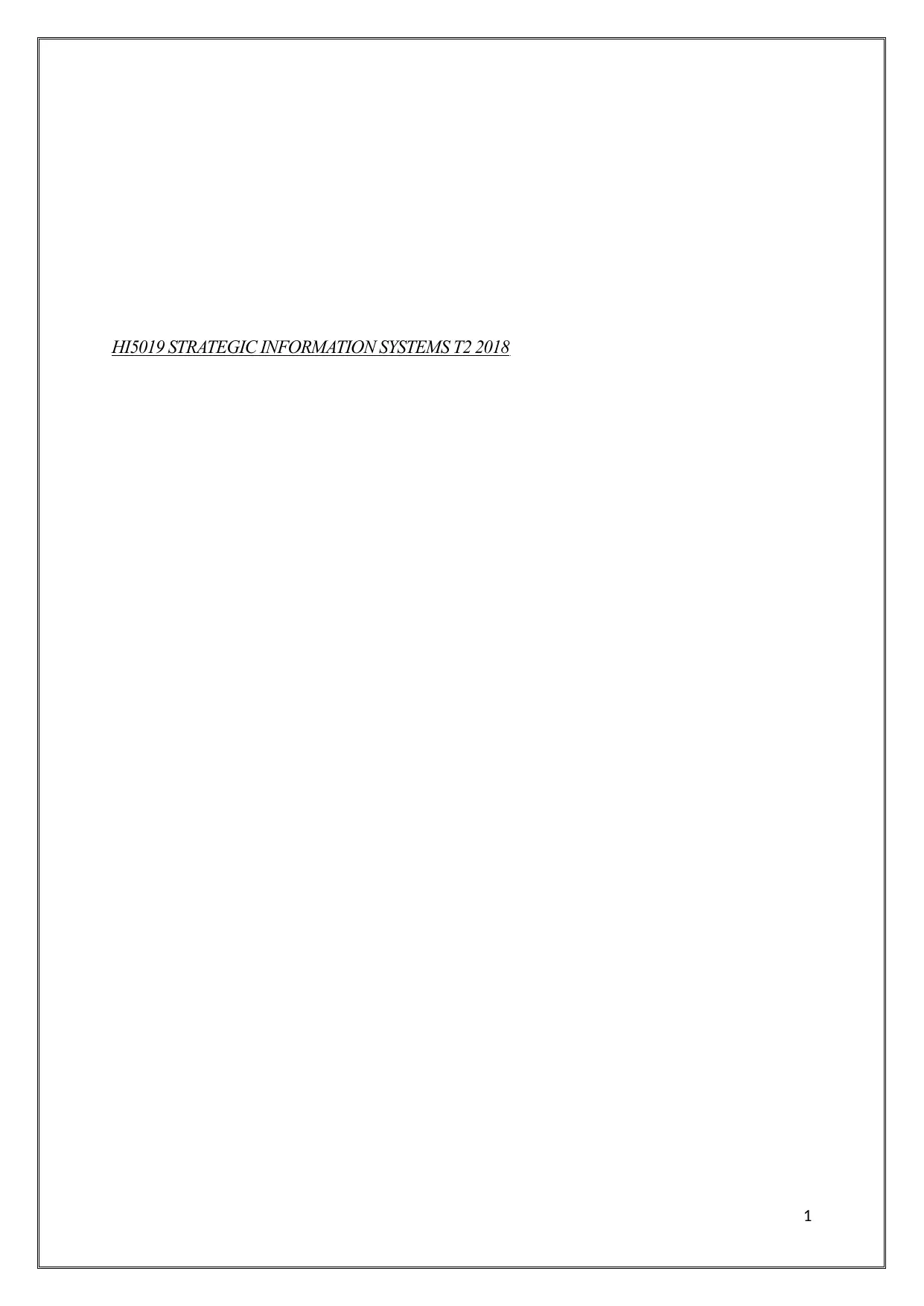
HI5019 STRATEGIC INFORMATION SYSTEMS T2 2018
1
1
Paraphrase This Document
Need a fresh take? Get an instant paraphrase of this document with our AI Paraphraser

Contents
Introduction................................................................................................................................ 2
Part 1: External Analysis............................................................................................................3
1. Business Background...................................................................................................... 3
2. What Industry is it?......................................................................................................... 4
3. General environment analysis......................................................................................... 4
4. Industry Environment Analysis.......................................................................................5
6. Opportunities and Threats............................................................................................... 6
Part 2- Internal Analysis and Proposal.......................................................................................6
1. The Resources of the Organisation................................................................................. 6
2. Capabilities Identification...............................................................................................7
3. Core competency analysis...............................................................................................7
4. Suitable information system............................................................................................8
5. Evaluate the proposed system and provide your recommendations...............................8
Conclusion................................................................................................................................10
References................................................................................................................................ 11
2
Introduction................................................................................................................................ 2
Part 1: External Analysis............................................................................................................3
1. Business Background...................................................................................................... 3
2. What Industry is it?......................................................................................................... 4
3. General environment analysis......................................................................................... 4
4. Industry Environment Analysis.......................................................................................5
6. Opportunities and Threats............................................................................................... 6
Part 2- Internal Analysis and Proposal.......................................................................................6
1. The Resources of the Organisation................................................................................. 6
2. Capabilities Identification...............................................................................................7
3. Core competency analysis...............................................................................................7
4. Suitable information system............................................................................................8
5. Evaluate the proposed system and provide your recommendations...............................8
Conclusion................................................................................................................................10
References................................................................................................................................ 11
2

Introduction
Strategic analysis is crucial for industries to gather and analyse crucial data related to both
internal and external corporate environment. In this report, a strategic analysis of Adelaide
Brighton Ltd, a cement manufacturing industry will be done. For that purpose, the internal
and external business environment will be studied and evaluated by making use of PESTLE,
Porter's five force models. The competing environment will be studied in the context of the
industry. The second part of the report will talk about the internal analysis of the company.
For that purpose, the core competencies will be analysed and a suitable information system
will be proposed. The report will conclude with certain recommendations regarding the same.
3
Strategic analysis is crucial for industries to gather and analyse crucial data related to both
internal and external corporate environment. In this report, a strategic analysis of Adelaide
Brighton Ltd, a cement manufacturing industry will be done. For that purpose, the internal
and external business environment will be studied and evaluated by making use of PESTLE,
Porter's five force models. The competing environment will be studied in the context of the
industry. The second part of the report will talk about the internal analysis of the company.
For that purpose, the core competencies will be analysed and a suitable information system
will be proposed. The report will conclude with certain recommendations regarding the same.
3
⊘ This is a preview!⊘
Do you want full access?
Subscribe today to unlock all pages.

Trusted by 1+ million students worldwide
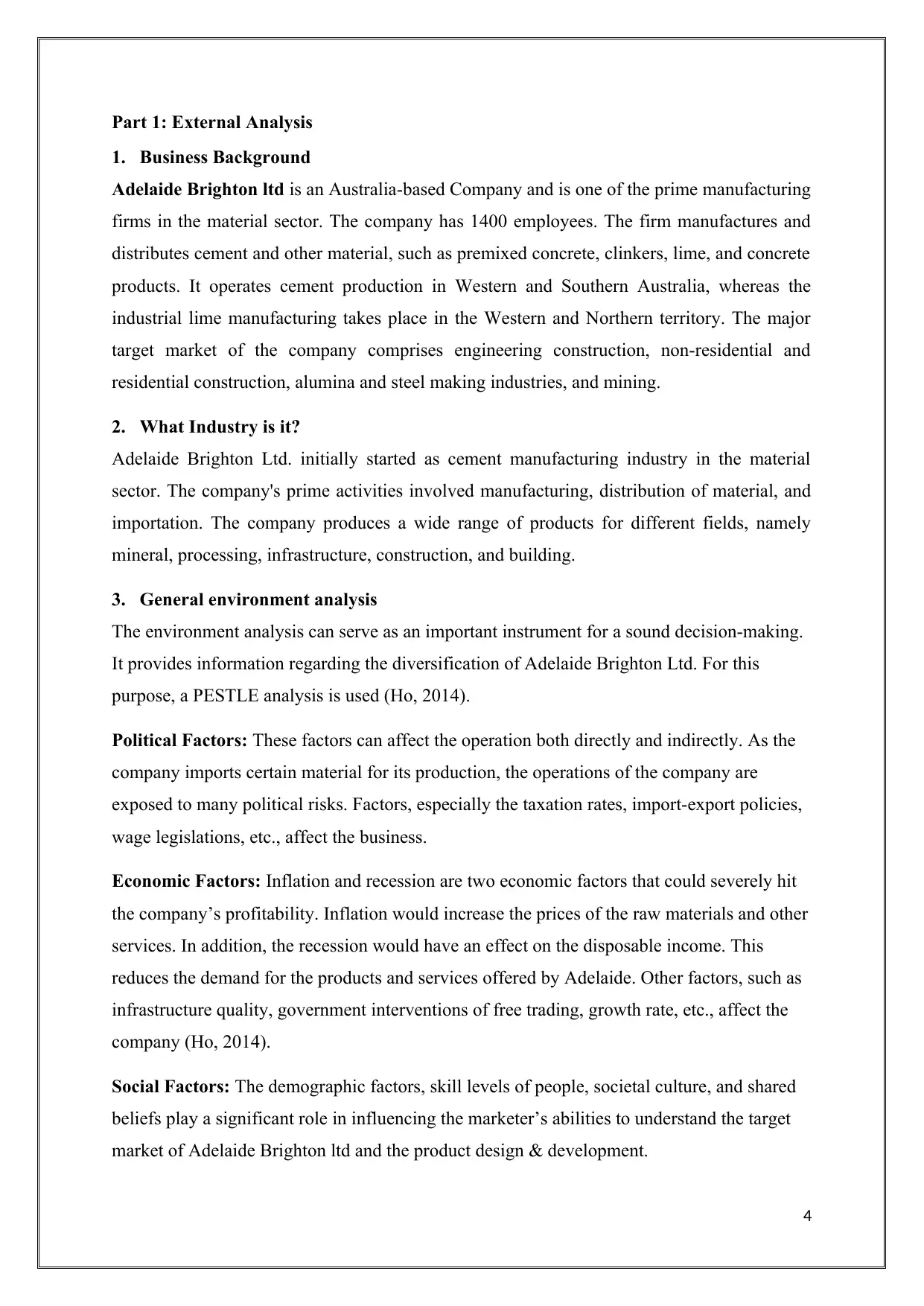
Part 1: External Analysis
1. Business Background
Adelaide Brighton ltd is an Australia-based Company and is one of the prime manufacturing
firms in the material sector. The company has 1400 employees. The firm manufactures and
distributes cement and other material, such as premixed concrete, clinkers, lime, and concrete
products. It operates cement production in Western and Southern Australia, whereas the
industrial lime manufacturing takes place in the Western and Northern territory. The major
target market of the company comprises engineering construction, non-residential and
residential construction, alumina and steel making industries, and mining.
2. What Industry is it?
Adelaide Brighton Ltd. initially started as cement manufacturing industry in the material
sector. The company's prime activities involved manufacturing, distribution of material, and
importation. The company produces a wide range of products for different fields, namely
mineral, processing, infrastructure, construction, and building.
3. General environment analysis
The environment analysis can serve as an important instrument for a sound decision-making.
It provides information regarding the diversification of Adelaide Brighton Ltd. For this
purpose, a PESTLE analysis is used (Ho, 2014).
Political Factors: These factors can affect the operation both directly and indirectly. As the
company imports certain material for its production, the operations of the company are
exposed to many political risks. Factors, especially the taxation rates, import-export policies,
wage legislations, etc., affect the business.
Economic Factors: Inflation and recession are two economic factors that could severely hit
the company’s profitability. Inflation would increase the prices of the raw materials and other
services. In addition, the recession would have an effect on the disposable income. This
reduces the demand for the products and services offered by Adelaide. Other factors, such as
infrastructure quality, government interventions of free trading, growth rate, etc., affect the
company (Ho, 2014).
Social Factors: The demographic factors, skill levels of people, societal culture, and shared
beliefs play a significant role in influencing the marketer’s abilities to understand the target
market of Adelaide Brighton ltd and the product design & development.
4
1. Business Background
Adelaide Brighton ltd is an Australia-based Company and is one of the prime manufacturing
firms in the material sector. The company has 1400 employees. The firm manufactures and
distributes cement and other material, such as premixed concrete, clinkers, lime, and concrete
products. It operates cement production in Western and Southern Australia, whereas the
industrial lime manufacturing takes place in the Western and Northern territory. The major
target market of the company comprises engineering construction, non-residential and
residential construction, alumina and steel making industries, and mining.
2. What Industry is it?
Adelaide Brighton Ltd. initially started as cement manufacturing industry in the material
sector. The company's prime activities involved manufacturing, distribution of material, and
importation. The company produces a wide range of products for different fields, namely
mineral, processing, infrastructure, construction, and building.
3. General environment analysis
The environment analysis can serve as an important instrument for a sound decision-making.
It provides information regarding the diversification of Adelaide Brighton Ltd. For this
purpose, a PESTLE analysis is used (Ho, 2014).
Political Factors: These factors can affect the operation both directly and indirectly. As the
company imports certain material for its production, the operations of the company are
exposed to many political risks. Factors, especially the taxation rates, import-export policies,
wage legislations, etc., affect the business.
Economic Factors: Inflation and recession are two economic factors that could severely hit
the company’s profitability. Inflation would increase the prices of the raw materials and other
services. In addition, the recession would have an effect on the disposable income. This
reduces the demand for the products and services offered by Adelaide. Other factors, such as
infrastructure quality, government interventions of free trading, growth rate, etc., affect the
company (Ho, 2014).
Social Factors: The demographic factors, skill levels of people, societal culture, and shared
beliefs play a significant role in influencing the marketer’s abilities to understand the target
market of Adelaide Brighton ltd and the product design & development.
4
Paraphrase This Document
Need a fresh take? Get an instant paraphrase of this document with our AI Paraphraser
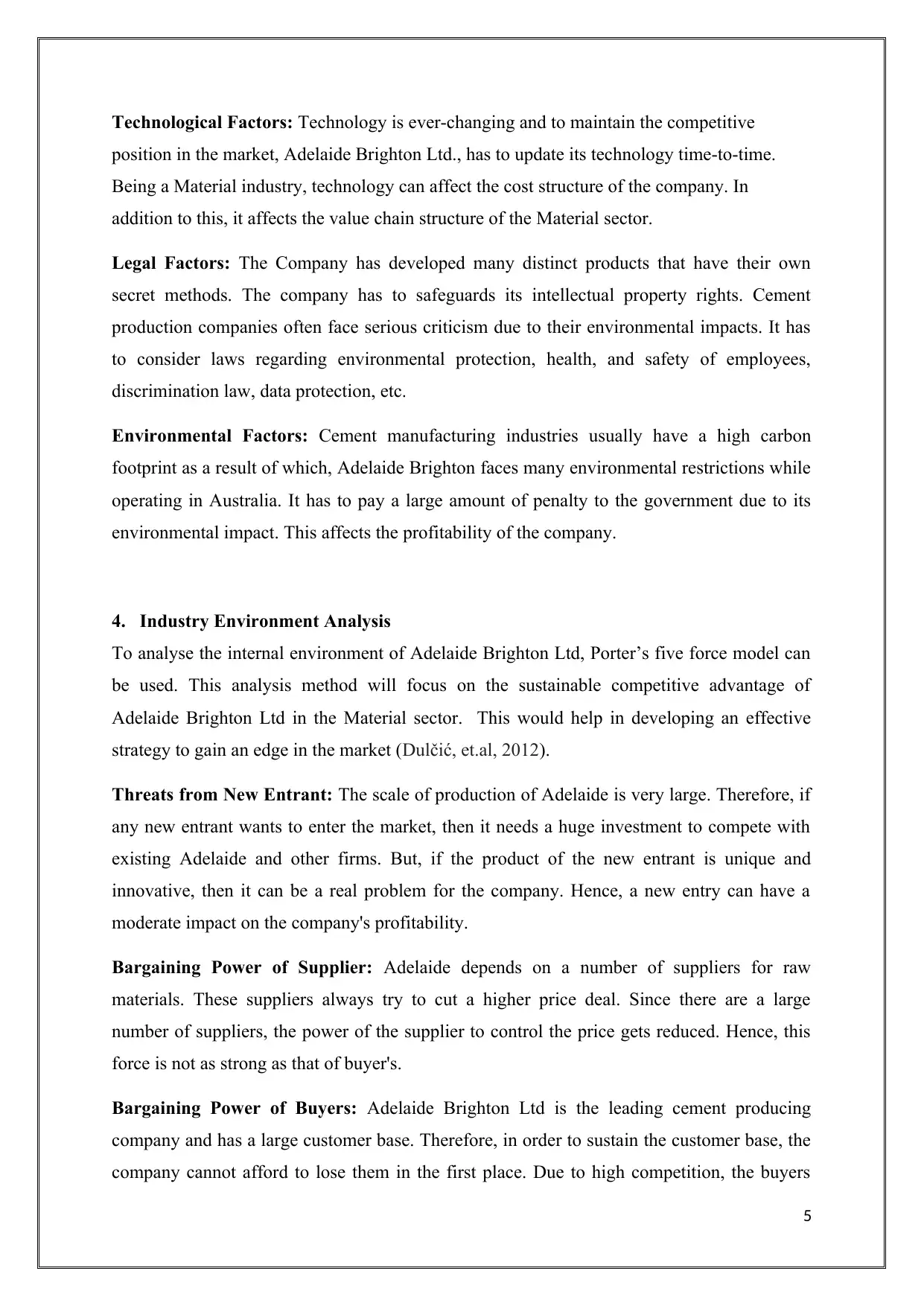
Technological Factors: Technology is ever-changing and to maintain the competitive
position in the market, Adelaide Brighton Ltd., has to update its technology time-to-time.
Being a Material industry, technology can affect the cost structure of the company. In
addition to this, it affects the value chain structure of the Material sector.
Legal Factors: The Company has developed many distinct products that have their own
secret methods. The company has to safeguards its intellectual property rights. Cement
production companies often face serious criticism due to their environmental impacts. It has
to consider laws regarding environmental protection, health, and safety of employees,
discrimination law, data protection, etc.
Environmental Factors: Cement manufacturing industries usually have a high carbon
footprint as a result of which, Adelaide Brighton faces many environmental restrictions while
operating in Australia. It has to pay a large amount of penalty to the government due to its
environmental impact. This affects the profitability of the company.
4. Industry Environment Analysis
To analyse the internal environment of Adelaide Brighton Ltd, Porter’s five force model can
be used. This analysis method will focus on the sustainable competitive advantage of
Adelaide Brighton Ltd in the Material sector. This would help in developing an effective
strategy to gain an edge in the market (Dulčić, et.al, 2012).
Threats from New Entrant: The scale of production of Adelaide is very large. Therefore, if
any new entrant wants to enter the market, then it needs a huge investment to compete with
existing Adelaide and other firms. But, if the product of the new entrant is unique and
innovative, then it can be a real problem for the company. Hence, a new entry can have a
moderate impact on the company's profitability.
Bargaining Power of Supplier: Adelaide depends on a number of suppliers for raw
materials. These suppliers always try to cut a higher price deal. Since there are a large
number of suppliers, the power of the supplier to control the price gets reduced. Hence, this
force is not as strong as that of buyer's.
Bargaining Power of Buyers: Adelaide Brighton Ltd is the leading cement producing
company and has a large customer base. Therefore, in order to sustain the customer base, the
company cannot afford to lose them in the first place. Due to high competition, the buyers
5
position in the market, Adelaide Brighton Ltd., has to update its technology time-to-time.
Being a Material industry, technology can affect the cost structure of the company. In
addition to this, it affects the value chain structure of the Material sector.
Legal Factors: The Company has developed many distinct products that have their own
secret methods. The company has to safeguards its intellectual property rights. Cement
production companies often face serious criticism due to their environmental impacts. It has
to consider laws regarding environmental protection, health, and safety of employees,
discrimination law, data protection, etc.
Environmental Factors: Cement manufacturing industries usually have a high carbon
footprint as a result of which, Adelaide Brighton faces many environmental restrictions while
operating in Australia. It has to pay a large amount of penalty to the government due to its
environmental impact. This affects the profitability of the company.
4. Industry Environment Analysis
To analyse the internal environment of Adelaide Brighton Ltd, Porter’s five force model can
be used. This analysis method will focus on the sustainable competitive advantage of
Adelaide Brighton Ltd in the Material sector. This would help in developing an effective
strategy to gain an edge in the market (Dulčić, et.al, 2012).
Threats from New Entrant: The scale of production of Adelaide is very large. Therefore, if
any new entrant wants to enter the market, then it needs a huge investment to compete with
existing Adelaide and other firms. But, if the product of the new entrant is unique and
innovative, then it can be a real problem for the company. Hence, a new entry can have a
moderate impact on the company's profitability.
Bargaining Power of Supplier: Adelaide depends on a number of suppliers for raw
materials. These suppliers always try to cut a higher price deal. Since there are a large
number of suppliers, the power of the supplier to control the price gets reduced. Hence, this
force is not as strong as that of buyer's.
Bargaining Power of Buyers: Adelaide Brighton Ltd is the leading cement producing
company and has a large customer base. Therefore, in order to sustain the customer base, the
company cannot afford to lose them in the first place. Due to high competition, the buyers
5
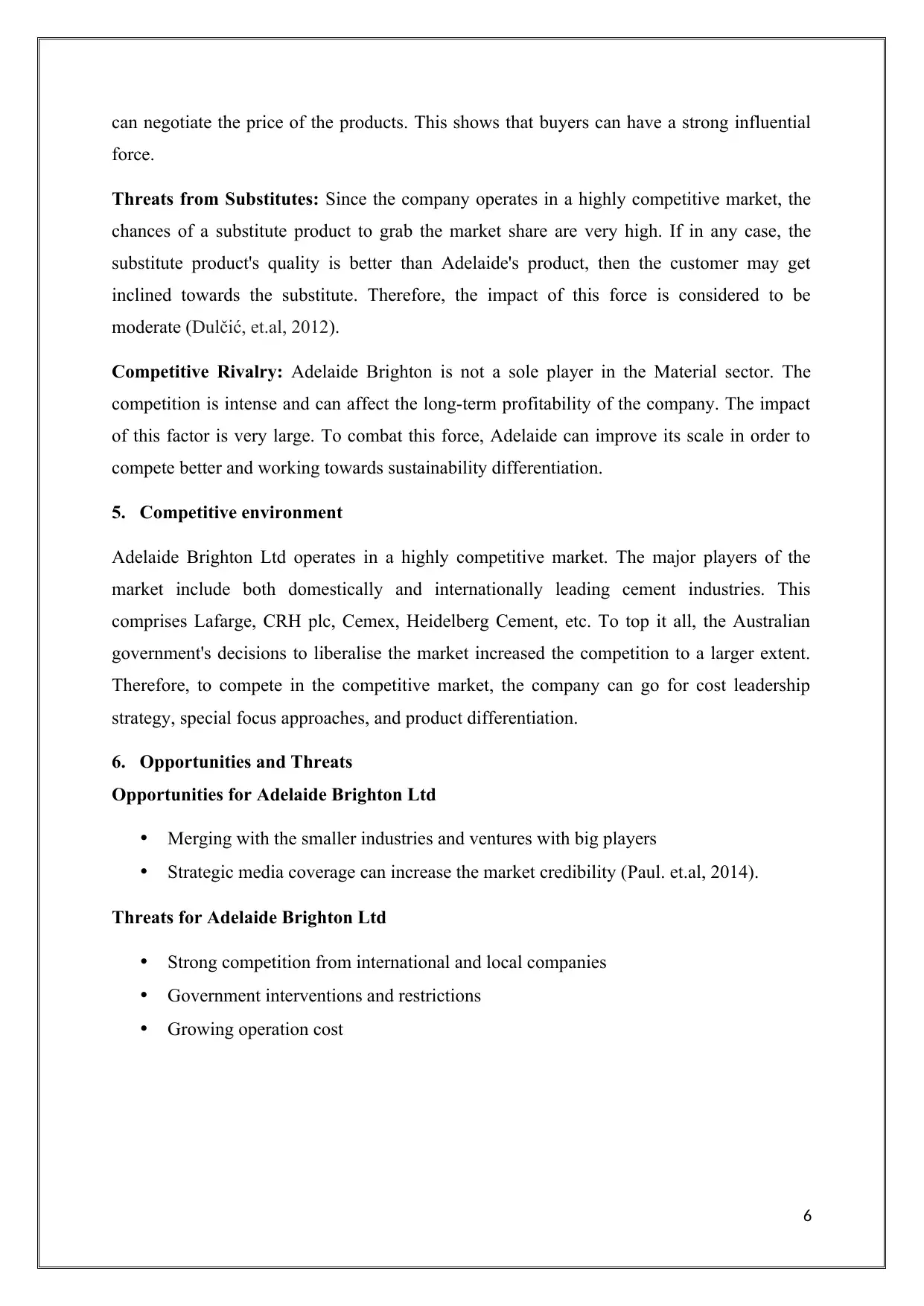
can negotiate the price of the products. This shows that buyers can have a strong influential
force.
Threats from Substitutes: Since the company operates in a highly competitive market, the
chances of a substitute product to grab the market share are very high. If in any case, the
substitute product's quality is better than Adelaide's product, then the customer may get
inclined towards the substitute. Therefore, the impact of this force is considered to be
moderate (Dulčić, et.al, 2012).
Competitive Rivalry: Adelaide Brighton is not a sole player in the Material sector. The
competition is intense and can affect the long-term profitability of the company. The impact
of this factor is very large. To combat this force, Adelaide can improve its scale in order to
compete better and working towards sustainability differentiation.
5. Competitive environment
Adelaide Brighton Ltd operates in a highly competitive market. The major players of the
market include both domestically and internationally leading cement industries. This
comprises Lafarge, CRH plc, Cemex, Heidelberg Cement, etc. To top it all, the Australian
government's decisions to liberalise the market increased the competition to a larger extent.
Therefore, to compete in the competitive market, the company can go for cost leadership
strategy, special focus approaches, and product differentiation.
6. Opportunities and Threats
Opportunities for Adelaide Brighton Ltd
Merging with the smaller industries and ventures with big players
Strategic media coverage can increase the market credibility (Paul. et.al, 2014).
Threats for Adelaide Brighton Ltd
Strong competition from international and local companies
Government interventions and restrictions
Growing operation cost
6
force.
Threats from Substitutes: Since the company operates in a highly competitive market, the
chances of a substitute product to grab the market share are very high. If in any case, the
substitute product's quality is better than Adelaide's product, then the customer may get
inclined towards the substitute. Therefore, the impact of this force is considered to be
moderate (Dulčić, et.al, 2012).
Competitive Rivalry: Adelaide Brighton is not a sole player in the Material sector. The
competition is intense and can affect the long-term profitability of the company. The impact
of this factor is very large. To combat this force, Adelaide can improve its scale in order to
compete better and working towards sustainability differentiation.
5. Competitive environment
Adelaide Brighton Ltd operates in a highly competitive market. The major players of the
market include both domestically and internationally leading cement industries. This
comprises Lafarge, CRH plc, Cemex, Heidelberg Cement, etc. To top it all, the Australian
government's decisions to liberalise the market increased the competition to a larger extent.
Therefore, to compete in the competitive market, the company can go for cost leadership
strategy, special focus approaches, and product differentiation.
6. Opportunities and Threats
Opportunities for Adelaide Brighton Ltd
Merging with the smaller industries and ventures with big players
Strategic media coverage can increase the market credibility (Paul. et.al, 2014).
Threats for Adelaide Brighton Ltd
Strong competition from international and local companies
Government interventions and restrictions
Growing operation cost
6
⊘ This is a preview!⊘
Do you want full access?
Subscribe today to unlock all pages.

Trusted by 1+ million students worldwide
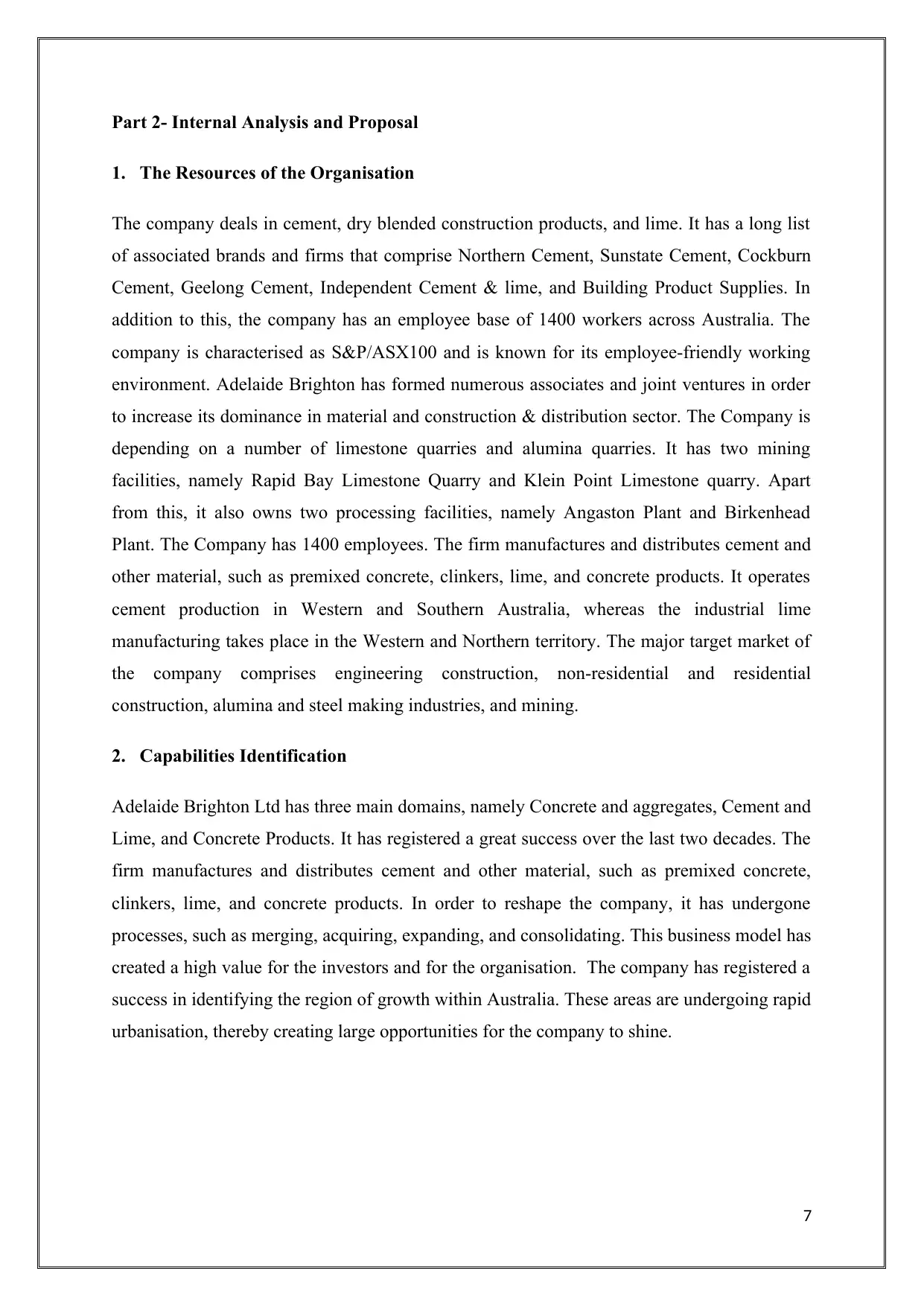
Part 2- Internal Analysis and Proposal
1. The Resources of the Organisation
The company deals in cement, dry blended construction products, and lime. It has a long list
of associated brands and firms that comprise Northern Cement, Sunstate Cement, Cockburn
Cement, Geelong Cement, Independent Cement & lime, and Building Product Supplies. In
addition to this, the company has an employee base of 1400 workers across Australia. The
company is characterised as S&P/ASX100 and is known for its employee-friendly working
environment. Adelaide Brighton has formed numerous associates and joint ventures in order
to increase its dominance in material and construction & distribution sector. The Company is
depending on a number of limestone quarries and alumina quarries. It has two mining
facilities, namely Rapid Bay Limestone Quarry and Klein Point Limestone quarry. Apart
from this, it also owns two processing facilities, namely Angaston Plant and Birkenhead
Plant. The Company has 1400 employees. The firm manufactures and distributes cement and
other material, such as premixed concrete, clinkers, lime, and concrete products. It operates
cement production in Western and Southern Australia, whereas the industrial lime
manufacturing takes place in the Western and Northern territory. The major target market of
the company comprises engineering construction, non-residential and residential
construction, alumina and steel making industries, and mining.
2. Capabilities Identification
Adelaide Brighton Ltd has three main domains, namely Concrete and aggregates, Cement and
Lime, and Concrete Products. It has registered a great success over the last two decades. The
firm manufactures and distributes cement and other material, such as premixed concrete,
clinkers, lime, and concrete products. In order to reshape the company, it has undergone
processes, such as merging, acquiring, expanding, and consolidating. This business model has
created a high value for the investors and for the organisation. The company has registered a
success in identifying the region of growth within Australia. These areas are undergoing rapid
urbanisation, thereby creating large opportunities for the company to shine.
7
1. The Resources of the Organisation
The company deals in cement, dry blended construction products, and lime. It has a long list
of associated brands and firms that comprise Northern Cement, Sunstate Cement, Cockburn
Cement, Geelong Cement, Independent Cement & lime, and Building Product Supplies. In
addition to this, the company has an employee base of 1400 workers across Australia. The
company is characterised as S&P/ASX100 and is known for its employee-friendly working
environment. Adelaide Brighton has formed numerous associates and joint ventures in order
to increase its dominance in material and construction & distribution sector. The Company is
depending on a number of limestone quarries and alumina quarries. It has two mining
facilities, namely Rapid Bay Limestone Quarry and Klein Point Limestone quarry. Apart
from this, it also owns two processing facilities, namely Angaston Plant and Birkenhead
Plant. The Company has 1400 employees. The firm manufactures and distributes cement and
other material, such as premixed concrete, clinkers, lime, and concrete products. It operates
cement production in Western and Southern Australia, whereas the industrial lime
manufacturing takes place in the Western and Northern territory. The major target market of
the company comprises engineering construction, non-residential and residential
construction, alumina and steel making industries, and mining.
2. Capabilities Identification
Adelaide Brighton Ltd has three main domains, namely Concrete and aggregates, Cement and
Lime, and Concrete Products. It has registered a great success over the last two decades. The
firm manufactures and distributes cement and other material, such as premixed concrete,
clinkers, lime, and concrete products. In order to reshape the company, it has undergone
processes, such as merging, acquiring, expanding, and consolidating. This business model has
created a high value for the investors and for the organisation. The company has registered a
success in identifying the region of growth within Australia. These areas are undergoing rapid
urbanisation, thereby creating large opportunities for the company to shine.
7
Paraphrase This Document
Need a fresh take? Get an instant paraphrase of this document with our AI Paraphraser
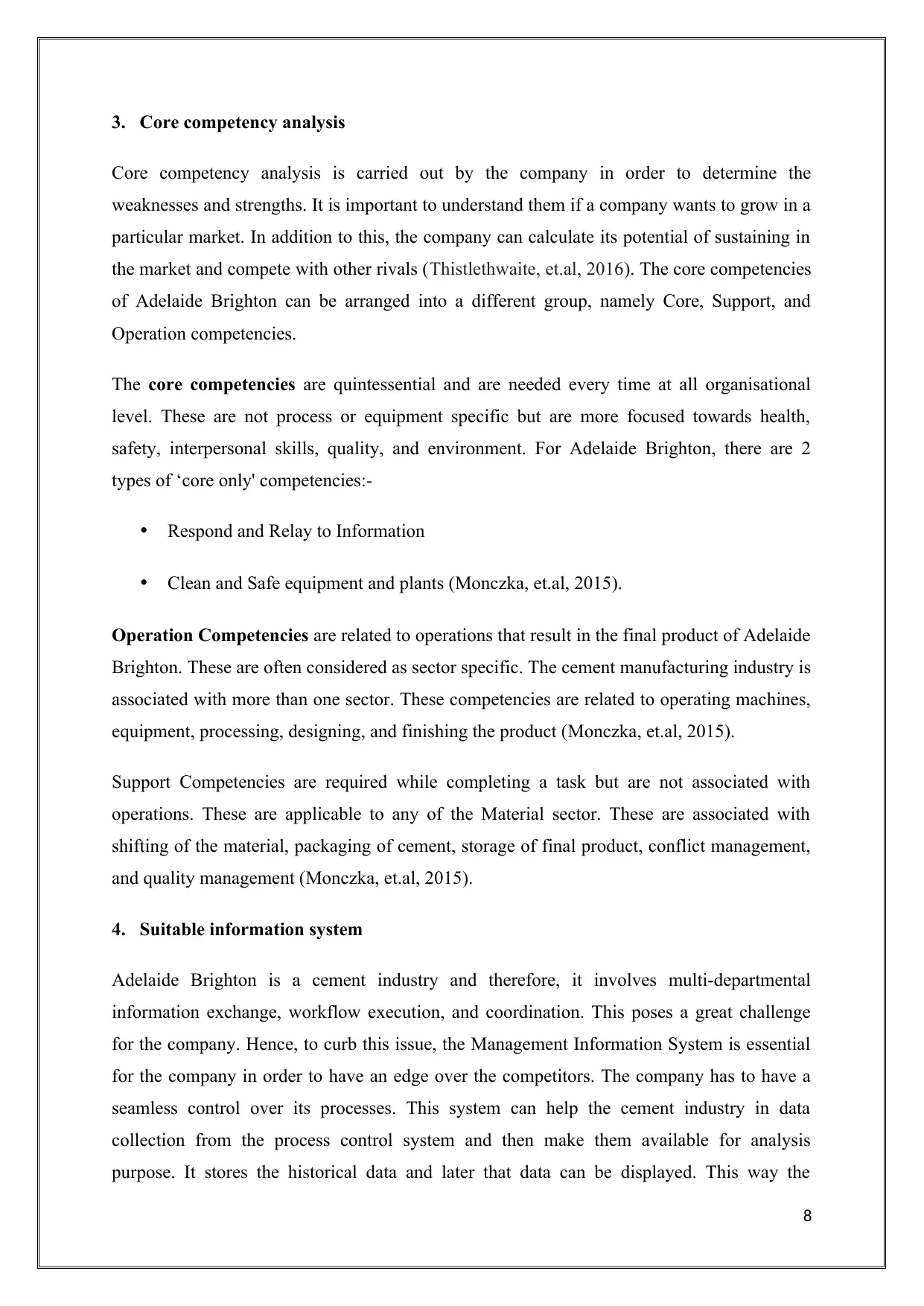
3. Core competency analysis
Core competency analysis is carried out by the company in order to determine the
weaknesses and strengths. It is important to understand them if a company wants to grow in a
particular market. In addition to this, the company can calculate its potential of sustaining in
the market and compete with other rivals (Thistlethwaite, et.al, 2016). The core competencies
of Adelaide Brighton can be arranged into a different group, namely Core, Support, and
Operation competencies.
The core competencies are quintessential and are needed every time at all organisational
level. These are not process or equipment specific but are more focused towards health,
safety, interpersonal skills, quality, and environment. For Adelaide Brighton, there are 2
types of ‘core only' competencies:-
Respond and Relay to Information
Clean and Safe equipment and plants (Monczka, et.al, 2015).
Operation Competencies are related to operations that result in the final product of Adelaide
Brighton. These are often considered as sector specific. The cement manufacturing industry is
associated with more than one sector. These competencies are related to operating machines,
equipment, processing, designing, and finishing the product (Monczka, et.al, 2015).
Support Competencies are required while completing a task but are not associated with
operations. These are applicable to any of the Material sector. These are associated with
shifting of the material, packaging of cement, storage of final product, conflict management,
and quality management (Monczka, et.al, 2015).
4. Suitable information system
Adelaide Brighton is a cement industry and therefore, it involves multi-departmental
information exchange, workflow execution, and coordination. This poses a great challenge
for the company. Hence, to curb this issue, the Management Information System is essential
for the company in order to have an edge over the competitors. The company has to have a
seamless control over its processes. This system can help the cement industry in data
collection from the process control system and then make them available for analysis
purpose. It stores the historical data and later that data can be displayed. This way the
8
Core competency analysis is carried out by the company in order to determine the
weaknesses and strengths. It is important to understand them if a company wants to grow in a
particular market. In addition to this, the company can calculate its potential of sustaining in
the market and compete with other rivals (Thistlethwaite, et.al, 2016). The core competencies
of Adelaide Brighton can be arranged into a different group, namely Core, Support, and
Operation competencies.
The core competencies are quintessential and are needed every time at all organisational
level. These are not process or equipment specific but are more focused towards health,
safety, interpersonal skills, quality, and environment. For Adelaide Brighton, there are 2
types of ‘core only' competencies:-
Respond and Relay to Information
Clean and Safe equipment and plants (Monczka, et.al, 2015).
Operation Competencies are related to operations that result in the final product of Adelaide
Brighton. These are often considered as sector specific. The cement manufacturing industry is
associated with more than one sector. These competencies are related to operating machines,
equipment, processing, designing, and finishing the product (Monczka, et.al, 2015).
Support Competencies are required while completing a task but are not associated with
operations. These are applicable to any of the Material sector. These are associated with
shifting of the material, packaging of cement, storage of final product, conflict management,
and quality management (Monczka, et.al, 2015).
4. Suitable information system
Adelaide Brighton is a cement industry and therefore, it involves multi-departmental
information exchange, workflow execution, and coordination. This poses a great challenge
for the company. Hence, to curb this issue, the Management Information System is essential
for the company in order to have an edge over the competitors. The company has to have a
seamless control over its processes. This system can help the cement industry in data
collection from the process control system and then make them available for analysis
purpose. It stores the historical data and later that data can be displayed. This way the
8

company can compare one plant with other by making use of certain trend charts at a
different time interval. Furthermore, the business organisation is greatly affected by the
globalisation. This may shift the whole business market majorly. Hence, proficient MIS
system can help in improving the business commitment and management.
5. Evaluate the proposed system and provide your recommendations
The suggested Management Information System has both advantages and challenges. The
major advantages of this system are:-
The cement production plant can be optimised through trend analysis (Aithal, 2017).
It can help in enhancing the production as data can be compared (Lee, 2012).
It can improve the quality of information from different reports can be integrated
It can reduce the overall cost as it analysis the alarms from various process control
systems.
On the other hand, there are some challenges also:-
The quality of the MIS is highly dependent on the quality of the information it
archives. This can give misleading results.
Another issue that is a major concern for the organisation is a data security issue.
Hackers and saboteurs are always on a hunt to breach their security and steal their
business secrets (Laudon and Laudon, 2015).
Recommendations for the Information System
The organisation should make a Technology Usage Agreement for its staff. This
should emphasise certain compliance issues like data confidentiality, downloading
inappropriate videos that give access to the hackers.
Create a comprehensive plan regarding the use of the technology plan.
It should create an off-site storage for data storing.
Scheduling the system maintenance in regular basis
9
different time interval. Furthermore, the business organisation is greatly affected by the
globalisation. This may shift the whole business market majorly. Hence, proficient MIS
system can help in improving the business commitment and management.
5. Evaluate the proposed system and provide your recommendations
The suggested Management Information System has both advantages and challenges. The
major advantages of this system are:-
The cement production plant can be optimised through trend analysis (Aithal, 2017).
It can help in enhancing the production as data can be compared (Lee, 2012).
It can improve the quality of information from different reports can be integrated
It can reduce the overall cost as it analysis the alarms from various process control
systems.
On the other hand, there are some challenges also:-
The quality of the MIS is highly dependent on the quality of the information it
archives. This can give misleading results.
Another issue that is a major concern for the organisation is a data security issue.
Hackers and saboteurs are always on a hunt to breach their security and steal their
business secrets (Laudon and Laudon, 2015).
Recommendations for the Information System
The organisation should make a Technology Usage Agreement for its staff. This
should emphasise certain compliance issues like data confidentiality, downloading
inappropriate videos that give access to the hackers.
Create a comprehensive plan regarding the use of the technology plan.
It should create an off-site storage for data storing.
Scheduling the system maintenance in regular basis
9
⊘ This is a preview!⊘
Do you want full access?
Subscribe today to unlock all pages.

Trusted by 1+ million students worldwide
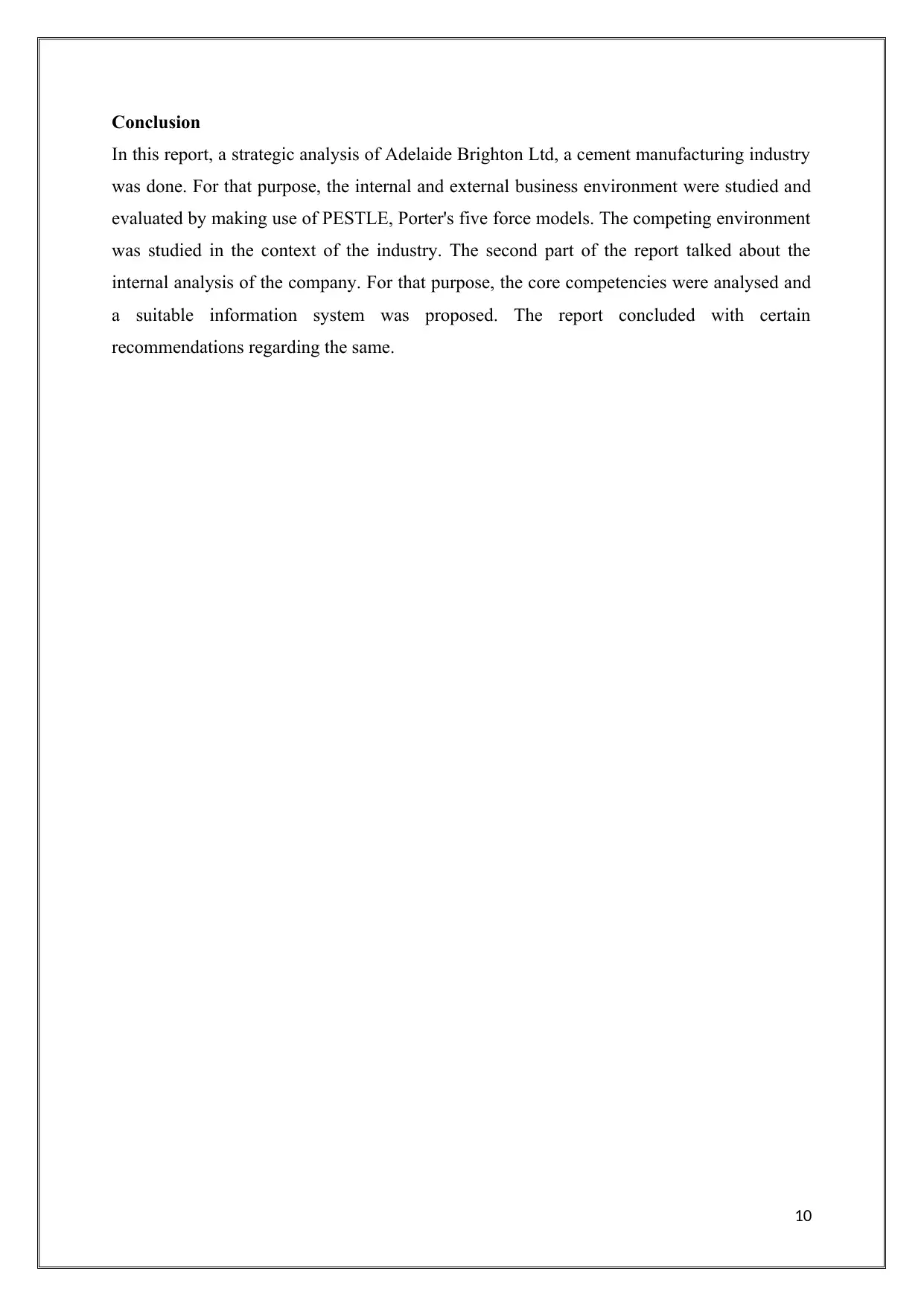
Conclusion
In this report, a strategic analysis of Adelaide Brighton Ltd, a cement manufacturing industry
was done. For that purpose, the internal and external business environment were studied and
evaluated by making use of PESTLE, Porter's five force models. The competing environment
was studied in the context of the industry. The second part of the report talked about the
internal analysis of the company. For that purpose, the core competencies were analysed and
a suitable information system was proposed. The report concluded with certain
recommendations regarding the same.
10
In this report, a strategic analysis of Adelaide Brighton Ltd, a cement manufacturing industry
was done. For that purpose, the internal and external business environment were studied and
evaluated by making use of PESTLE, Porter's five force models. The competing environment
was studied in the context of the industry. The second part of the report talked about the
internal analysis of the company. For that purpose, the core competencies were analysed and
a suitable information system was proposed. The report concluded with certain
recommendations regarding the same.
10
Paraphrase This Document
Need a fresh take? Get an instant paraphrase of this document with our AI Paraphraser
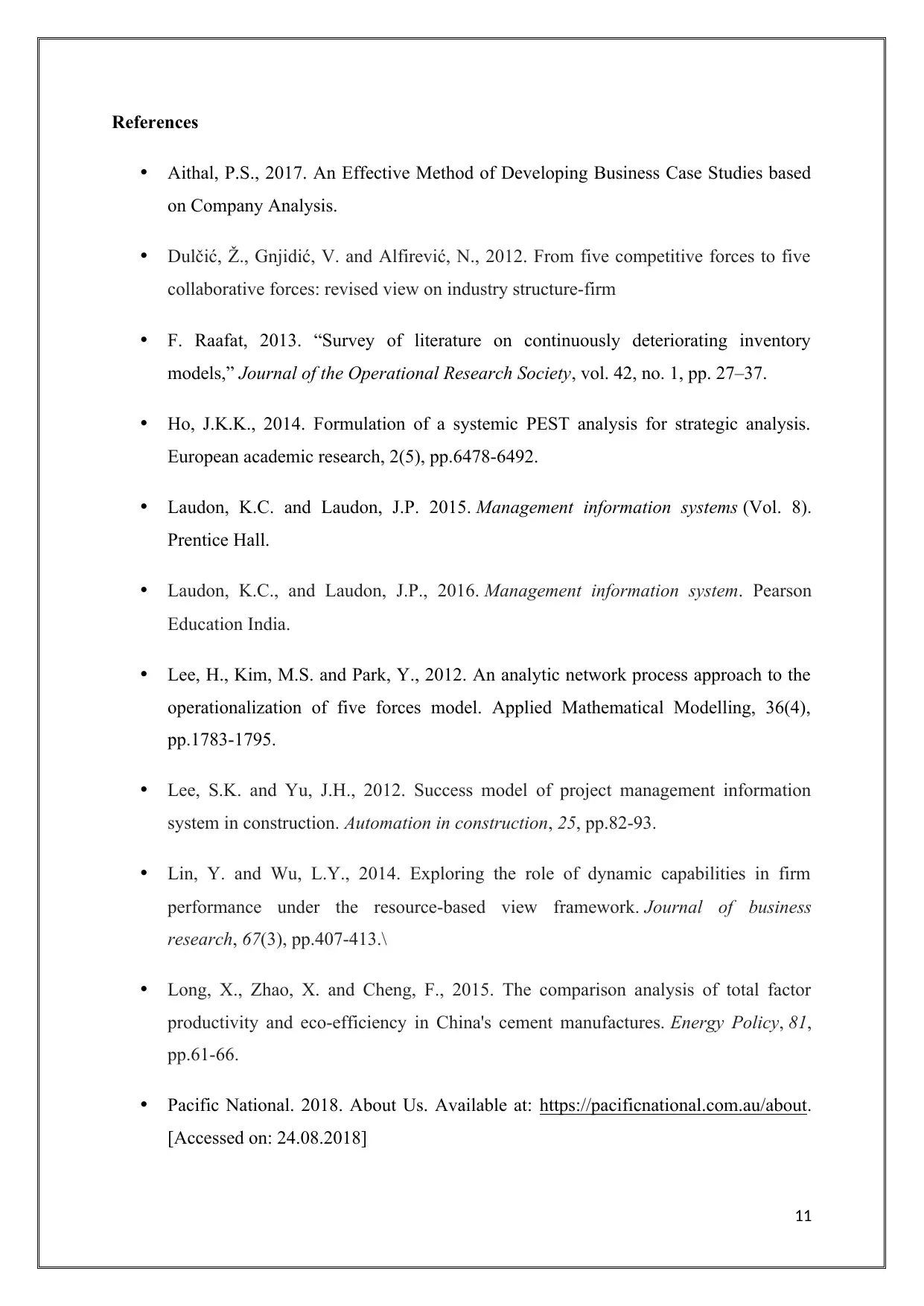
References
Aithal, P.S., 2017. An Effective Method of Developing Business Case Studies based
on Company Analysis.
Dulčić, Ž., Gnjidić, V. and Alfirević, N., 2012. From five competitive forces to five
collaborative forces: revised view on industry structure-firm
F. Raafat, 2013. “Survey of literature on continuously deteriorating inventory
models,” Journal of the Operational Research Society, vol. 42, no. 1, pp. 27–37.
Ho, J.K.K., 2014. Formulation of a systemic PEST analysis for strategic analysis.
European academic research, 2(5), pp.6478-6492.
Laudon, K.C. and Laudon, J.P. 2015. Management information systems (Vol. 8).
Prentice Hall.
Laudon, K.C., and Laudon, J.P., 2016. Management information system. Pearson
Education India.
Lee, H., Kim, M.S. and Park, Y., 2012. An analytic network process approach to the
operationalization of five forces model. Applied Mathematical Modelling, 36(4),
pp.1783-1795.
Lee, S.K. and Yu, J.H., 2012. Success model of project management information
system in construction. Automation in construction, 25, pp.82-93.
Lin, Y. and Wu, L.Y., 2014. Exploring the role of dynamic capabilities in firm
performance under the resource-based view framework. Journal of business
research, 67(3), pp.407-413.\
Long, X., Zhao, X. and Cheng, F., 2015. The comparison analysis of total factor
productivity and eco-efficiency in China's cement manufactures. Energy Policy, 81,
pp.61-66.
Pacific National. 2018. About Us. Available at: https://pacificnational.com.au/about.
[Accessed on: 24.08.2018]
11
Aithal, P.S., 2017. An Effective Method of Developing Business Case Studies based
on Company Analysis.
Dulčić, Ž., Gnjidić, V. and Alfirević, N., 2012. From five competitive forces to five
collaborative forces: revised view on industry structure-firm
F. Raafat, 2013. “Survey of literature on continuously deteriorating inventory
models,” Journal of the Operational Research Society, vol. 42, no. 1, pp. 27–37.
Ho, J.K.K., 2014. Formulation of a systemic PEST analysis for strategic analysis.
European academic research, 2(5), pp.6478-6492.
Laudon, K.C. and Laudon, J.P. 2015. Management information systems (Vol. 8).
Prentice Hall.
Laudon, K.C., and Laudon, J.P., 2016. Management information system. Pearson
Education India.
Lee, H., Kim, M.S. and Park, Y., 2012. An analytic network process approach to the
operationalization of five forces model. Applied Mathematical Modelling, 36(4),
pp.1783-1795.
Lee, S.K. and Yu, J.H., 2012. Success model of project management information
system in construction. Automation in construction, 25, pp.82-93.
Lin, Y. and Wu, L.Y., 2014. Exploring the role of dynamic capabilities in firm
performance under the resource-based view framework. Journal of business
research, 67(3), pp.407-413.\
Long, X., Zhao, X. and Cheng, F., 2015. The comparison analysis of total factor
productivity and eco-efficiency in China's cement manufactures. Energy Policy, 81,
pp.61-66.
Pacific National. 2018. About Us. Available at: https://pacificnational.com.au/about.
[Accessed on: 24.08.2018]
11
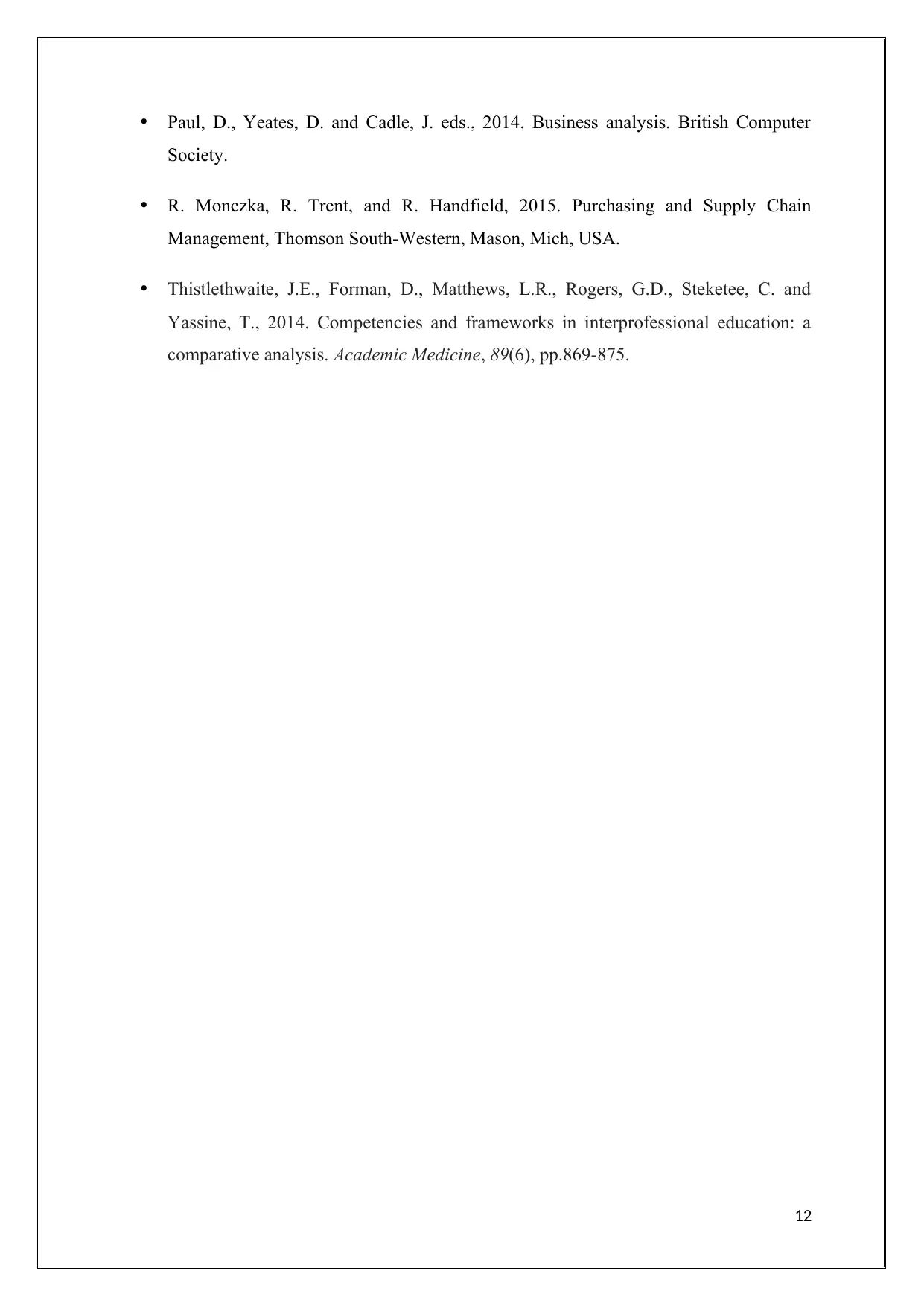
Paul, D., Yeates, D. and Cadle, J. eds., 2014. Business analysis. British Computer
Society.
R. Monczka, R. Trent, and R. Handfield, 2015. Purchasing and Supply Chain
Management, Thomson South-Western, Mason, Mich, USA.
Thistlethwaite, J.E., Forman, D., Matthews, L.R., Rogers, G.D., Steketee, C. and
Yassine, T., 2014. Competencies and frameworks in interprofessional education: a
comparative analysis. Academic Medicine, 89(6), pp.869-875.
12
Society.
R. Monczka, R. Trent, and R. Handfield, 2015. Purchasing and Supply Chain
Management, Thomson South-Western, Mason, Mich, USA.
Thistlethwaite, J.E., Forman, D., Matthews, L.R., Rogers, G.D., Steketee, C. and
Yassine, T., 2014. Competencies and frameworks in interprofessional education: a
comparative analysis. Academic Medicine, 89(6), pp.869-875.
12
⊘ This is a preview!⊘
Do you want full access?
Subscribe today to unlock all pages.

Trusted by 1+ million students worldwide
1 out of 12
Related Documents
Your All-in-One AI-Powered Toolkit for Academic Success.
+13062052269
info@desklib.com
Available 24*7 on WhatsApp / Email
![[object Object]](/_next/static/media/star-bottom.7253800d.svg)
Unlock your academic potential
Copyright © 2020–2025 A2Z Services. All Rights Reserved. Developed and managed by ZUCOL.





